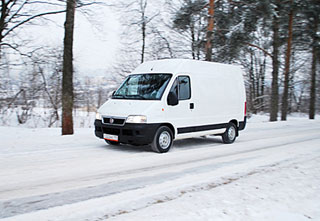Test drive Fiat Ducato Kombi since 2010 van
Italian emigrant

Fiat Ducato of Russian
Last year, the fifth generation of Fiat Ducato cars, produced from 2002 to 2007, has gained a new life. At the Sollers-Yelabuga plant in Tatarstan on May 27, licensed production of this model known in Russia began. Made in Russia came to us for a week. What will please the old new acquaintance?
The assembly of the Russian Ducato former production capacities, where they made the notorious SUV Chevrolet Blazer a joint project Elaz-GM. But under the Italian they organized a new production, investing $ 150 million in it and purchasing a new imported conveyor equipment. Therefore, Ducato with the RUS prefix is \u200b\u200bnot a screwdriver assembly. Only large nodes and units like an engine and checkpoint come from Italy. Everything else goes in detail. Further in Elabuga they themselves boil and paint the body and perform the final assembly. The shopping workshop of body parts will also work soon, which will almost completely localize production. So the Soldik Sollers-Hlabuga under the hood is not glued to the red word under the hood, but for now we set us in the cabin. Cabinet of a flea market. A bunch of pockets, pockets and niches in the doors and on a dashboard allow you to shove a lot of papers and small things on them, which are always on the way with a cargo carrier. The assembly of the salon is quite decent, everything is fitted tightly, nothing rattles nowhere, does not creak. Review is also at the level, but landing the steering wheel is on the bus, and if you sit closer and set it up for yourself, then the right knee supports the ignition key and the joystick of the checkpoint. Here would be adjusted the steering wheel by departure! The pedal node is cramped: the legs hurt the steering shaft, passing close to the pedals. There is a platform for the left leg, but it is tall and you can’t stretch your leg on long trips. Here it is, reckoning for layout with a short front overhang.
 Start key! Three diesel engines and a gasoline engine were offered on a purely Italian Ducato. But on Ducato, Russian is only one engine 4-cylinder 16-valve 2.3 JTD turbodiesel with a capacity of 110 hp, which was also used in commercial van IVECO Daily. The same motor, by the way, will soon begin to be assembled under a license at the capacities of the Zavolzh Motor Plant and put both on Ducato and on the UAZ Patriot. On the move, even an unnecessary motor pleased with a good rod from the bottom and a soft work, and the fuel consumption in the cycle, the empty-loaded swam around 8.5 liters per hundred.
Start key! Three diesel engines and a gasoline engine were offered on a purely Italian Ducato. But on Ducato, Russian is only one engine 4-cylinder 16-valve 2.3 JTD turbodiesel with a capacity of 110 hp, which was also used in commercial van IVECO Daily. The same motor, by the way, will soon begin to be assembled under a license at the capacities of the Zavolzh Motor Plant and put both on Ducato and on the UAZ Patriot. On the move, even an unnecessary motor pleased with a good rod from the bottom and a soft work, and the fuel consumption in the cycle, the empty-loaded swam around 8.5 liters per hundred. As for adapting to our market, the 2.3 JTD engine is in execution for a cold climate to the Russian conveyor, which includes a more powerful generator, a larger battery, heating the fuel filter and crankcase gases, as well as frost -resistant elastic bands. And since August 2008, all Italians produced in Elabuga have been equipped with a regular additional heater in the Webasto production engine. In general, the winter arsenal of Ducato born on warm apenins is quite serious. But the air conditioning for cargo vans is not yet offered even for a surcharge only for minibuses. Although the manufacturer promises to put the condo in the future, if there is demand.
On the move, even an empty van does not shake on bumps, like a rural cart: an independent McPherson front suspension with a reptile stability stabilizer and a low -leaved spring sprinkle mildly work unevenness. The engine crankcase is covered from below with a steel pallet, so you can not be afraid of bumps. Road steering has almost easy accuracy, and the brakes have a good grip. True, ABS for vans is also not proposed, so how many coating will you have to recall the techniques of intermittent braking.
To date, nine types of Ducato are being built in Elabuga. The basis of the van gamut with three bases (2850, 3200 and 3700 mm), three types of roofs and bodies with a volume of 7.5 to 14 m3 with a carrying capacity of 9901505 kg. There are also passenger versions: combi, minibus, minibus, ambulance. Production plans are considerable: by 201112. Go to the level of 75,000 cars per year. So far, the crisis has not made adjustments, although it seems that in any case, even in such volumes, it seems that in any case. The car is promoted, well studied on Fiat services and at a price occupies a vacant place between Gazelle and more expensive Europeans. So the Italian emigrant has a chance to take root on the Russian land.

The instrument panel is simple, concise and still looks quite modern. Quality of materials, assembly, availability of places for luggage at a decent level
Source: Cars

